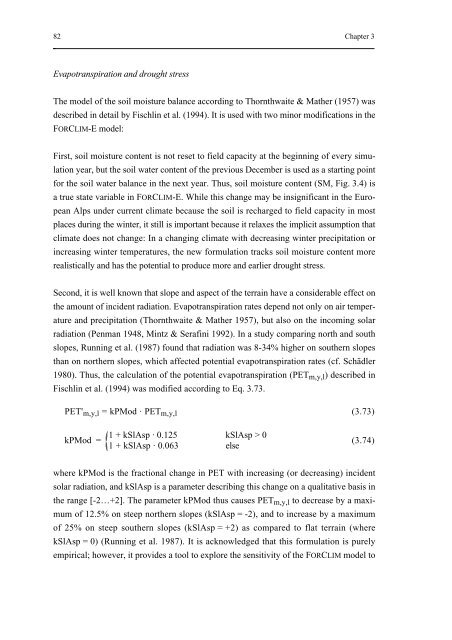On the Ecology of Mountainous Forests in a Changing Climate: A ...
On the Ecology of Mountainous Forests in a Changing Climate: A ...
On the Ecology of Mountainous Forests in a Changing Climate: A ...
You also want an ePaper? Increase the reach of your titles
YUMPU automatically turns print PDFs into web optimized ePapers that Google loves.
82 Chapter 3<br />
Evapotranspiration and drought stress<br />
The model <strong>of</strong> <strong>the</strong> soil moisture balance accord<strong>in</strong>g to Thornthwaite & Ma<strong>the</strong>r (1957) was<br />
described <strong>in</strong> detail by Fischl<strong>in</strong> et al. (1994). It is used with two m<strong>in</strong>or modifications <strong>in</strong> <strong>the</strong><br />
FORCLIM-E model:<br />
First, soil moisture content is not reset to field capacity at <strong>the</strong> beg<strong>in</strong>n<strong>in</strong>g <strong>of</strong> every simulation<br />
year, but <strong>the</strong> soil water content <strong>of</strong> <strong>the</strong> previous December is used as a start<strong>in</strong>g po<strong>in</strong>t<br />
for <strong>the</strong> soil water balance <strong>in</strong> <strong>the</strong> next year. Thus, soil moisture content (SM, Fig. 3.4) is<br />
a true state variable <strong>in</strong> FORCLIM-E. While this change may be <strong>in</strong>significant <strong>in</strong> <strong>the</strong> European<br />
Alps under current climate because <strong>the</strong> soil is recharged to field capacity <strong>in</strong> most<br />
places dur<strong>in</strong>g <strong>the</strong> w<strong>in</strong>ter, it still is important because it relaxes <strong>the</strong> implicit assumption that<br />
climate does not change: In a chang<strong>in</strong>g climate with decreas<strong>in</strong>g w<strong>in</strong>ter precipitation or<br />
<strong>in</strong>creas<strong>in</strong>g w<strong>in</strong>ter temperatures, <strong>the</strong> new formulation tracks soil moisture content more<br />
realistically and has <strong>the</strong> potential to produce more and earlier drought stress.<br />
Second, it is well known that slope and aspect <strong>of</strong> <strong>the</strong> terra<strong>in</strong> have a considerable effect on<br />
<strong>the</strong> amount <strong>of</strong> <strong>in</strong>cident radiation. Evapotranspiration rates depend not only on air temperature<br />
and precipitation (Thornthwaite & Ma<strong>the</strong>r 1957), but also on <strong>the</strong> <strong>in</strong>com<strong>in</strong>g solar<br />
radiation (Penman 1948, M<strong>in</strong>tz & Seraf<strong>in</strong>i 1992). In a study compar<strong>in</strong>g north and south<br />
slopes, Runn<strong>in</strong>g et al. (1987) found that radiation was 8-34% higher on sou<strong>the</strong>rn slopes<br />
than on nor<strong>the</strong>rn slopes, which affected potential evapotranspiration rates (cf. Schädler<br />
1980). Thus, <strong>the</strong> calculation <strong>of</strong> <strong>the</strong> potential evapotranspiration (PET m,y,l ) described <strong>in</strong><br />
Fischl<strong>in</strong> et al. (1994) was modified accord<strong>in</strong>g to Eq. 3.73.<br />
PET' m,y,l = kPMod · PET m,y,l (3.73)<br />
kPMod =<br />
1 + kSlAsp · 0.125 kSlAsp > 0<br />
1 + kSlAsp · 0.063 else<br />
(3.74)<br />
where kPMod is <strong>the</strong> fractional change <strong>in</strong> PET with <strong>in</strong>creas<strong>in</strong>g (or decreas<strong>in</strong>g) <strong>in</strong>cident<br />
solar radiation, and kSlAsp is a parameter describ<strong>in</strong>g this change on a qualitative basis <strong>in</strong><br />
<strong>the</strong> range [-2…+2]. The parameter kPMod thus causes PET m,y,l to decrease by a maximum<br />
<strong>of</strong> 12.5% on steep nor<strong>the</strong>rn slopes (kSlAsp = -2), and to <strong>in</strong>crease by a maximum<br />
<strong>of</strong> 25% on steep sou<strong>the</strong>rn slopes (kSlAsp = +2) as compared to flat terra<strong>in</strong> (where<br />
kSlAsp = 0) (Runn<strong>in</strong>g et al. 1987). It is acknowledged that this formulation is purely<br />
empirical; however, it provides a tool to explore <strong>the</strong> sensitivity <strong>of</strong> <strong>the</strong> FORCLIM model to















